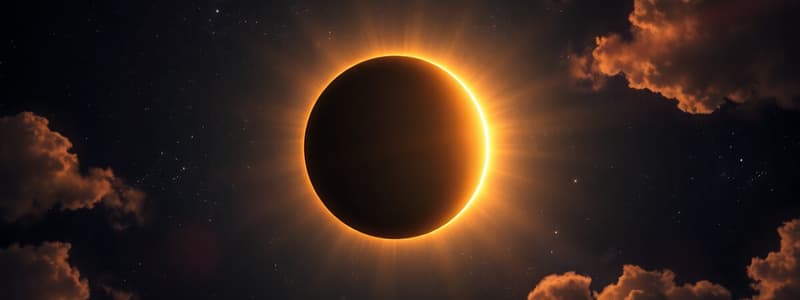Podcast
Questions and Answers
What perspective does point D provide during a solar eclipse?
What perspective does point D provide during a solar eclipse?
- A total blackout of the sun occurs.
- Partial solar eclipse is visible.
- The sun is fully visible. (correct)
- Total solar eclipse is visible.
Which scenario does not occur during the solar eclipse?
Which scenario does not occur during the solar eclipse?
- No eclipse
- Full moon eclipse (correct)
- Total solar eclipse
- Partial solar eclipse
What is the primary risk when observing a solar eclipse without proper protection?
What is the primary risk when observing a solar eclipse without proper protection?
- Permanent eye color change
- Increased brightness leading to temporary blindness
- Loss of night vision
- Ultraviolet rays that can cause eye damage (correct)
In the scenario of a total solar eclipse, what is the arrangement of the celestial bodies?
In the scenario of a total solar eclipse, what is the arrangement of the celestial bodies?
What can Asha infer by drawing a line from point D during the solar eclipse observation?
What can Asha infer by drawing a line from point D during the solar eclipse observation?
What condition allows a total solar eclipse to occur between points B and C on Earth?
What condition allows a total solar eclipse to occur between points B and C on Earth?
What will be seen from point D during a solar eclipse?
What will be seen from point D during a solar eclipse?
Which of the following statements is true regarding solar eclipses?
Which of the following statements is true regarding solar eclipses?
Which option best describes the shadow cast by the moon during a total solar eclipse?
Which option best describes the shadow cast by the moon during a total solar eclipse?
What can be inferred if sunlight reaches a point on Earth during an eclipse?
What can be inferred if sunlight reaches a point on Earth during an eclipse?
What is likely to happen if the moon is perfectly centered to block sunlight during a solar eclipse?
What is likely to happen if the moon is perfectly centered to block sunlight during a solar eclipse?
What would a person at point A experience during a partial eclipse?
What would a person at point A experience during a partial eclipse?
Which of the following statements describes the position of the moon during a partial solar eclipse according to the provided content?
Which of the following statements describes the position of the moon during a partial solar eclipse according to the provided content?
How does the visibility of the sun change for people located to the left of point A?
How does the visibility of the sun change for people located to the left of point A?
What concept can be inferred about shadows during a solar eclipse based on Mujibur's drawing?
What concept can be inferred about shadows during a solar eclipse based on Mujibur's drawing?
Flashcards are hidden until you start studying
Study Notes
Solar Eclipse Observation
- A total solar eclipse occurs when the moon is positioned directly between the sun and Earth.
- From a point on Earth where the moon is directly between the sun and Earth, a total solar eclipse will be visible.
- From a point on Earth where the moon is not directly between the sun and Earth, a total solar eclipse will not be visible.
- If the moon is not directly between the sun and Earth, but is positioned in a way that blocks part of the sun, a partial solar eclipse will occur.
- It's important to never look directly at the sun during an eclipse without proper eye protection.
### Solar Eclipse Explanation
- In a solar eclipse, the moon passes between the sun and Earth.
- Different parts of the Earth will experience different types of eclipses depending on their position relative to the moon and sun.
- During a partial eclipse, part of the sun is visible while the moon blocks another portion.
- During a total eclipse, the entire sun is blocked by the moon.
Fully covered, partially covered: Total eclipse, partial eclipse
- A line drawn from a point on Earth to the moon can depict which parts of the sun are visible or blocked.
- If the line from Earth touches the moon in a way that blocks the entire sun, a total solar eclipse is visible.
- If the line from Earth touches the moon in a way that only blocks part of the sun, a partial solar eclipse is visible.
- People who are on Earth where the sun is fully blocked experience a total eclipse.
- People who are on Earth where a portion of the sun remains visible, but some of the sun's rays are blocked, experience a partial eclipse.
- The extent of the eclipse determines the experience, with a total eclipse representing a complete blockage and a partial eclipse blocking only a portion of the sun.
### Figure 1
- A line drawn from a point on Earth to the moon shows which parts of the sun are visible or blocked.
- The moon being slightly off-center results in different portions of the sun being covered.
- The side of the line where the sun's rays are blocked indicates a partial eclipse.
- The side of the line where the sun's rays are not blocked, indicates a visible sun.
- The diagram shows the sun's rays as arrows.
Studying That Suits You
Use AI to generate personalized quizzes and flashcards to suit your learning preferences.




